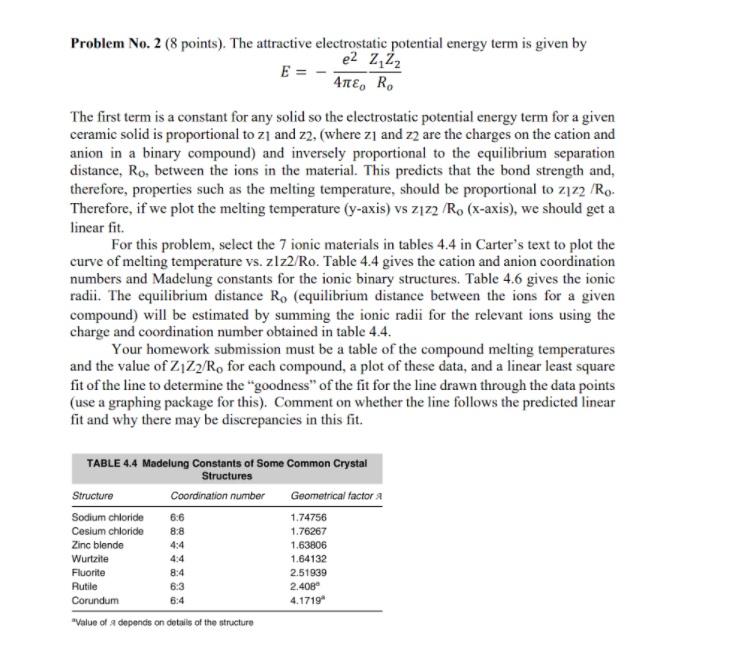
Problem No. 2 (8 points). The attractive electrostatic potential energy term is given by e2 Z 22 4, R, The first term is a constant for any solid so the electrostatic potential energy term for a given ceramic solid is proportional to z] and Z2, (where z] and Z2 are the charges on the cation and anion in a binary compound) and inversely proportional to the equilibrium separation distance, Ro, between the ions in the material. This predicts that the bond strength and, therefore, properties such as the melting temperature, should be proportional to z22 /Ro. Therefore, if we plot the melting temperature (y-axis) vs Z122 /R. (x-axis), we should get a linear fit. For this problem, select the 7 ionic materials in tables 4.4 in Carter's text to plot the curve of melting temperature vs. zlz2/Ro. Table 4.4 gives the cation and anion coordination numbers and Madelung constants for the ionic binary structures. Table 4.6 gives the ionic radii. The equilibrium distance Ro (equilibrium distance between the ions for a given compound) will be estimated by summing the ionic radii for the relevant ions using the charge and coordination number obtained in table 4.4. Your homework submission must be a table of the compound melting temperatures and the value of Z1Z/R, for each compound, a plot of these data, and a linear least square fit of the line to determine the "goodness of the fit for the line drawn through the data points (use a graphing package for this). Comment on whether the line follows the predicted linear fit and why there may be discrepancies in this fit. TABLE 4.4 Madelung Constants of Some Common Crystal Structures Structure Coordination number Geometrical factor a Sodium chloride 6:6 1.74756 Cesium chloride 8:8 1.76267 Zinc blende 4:4 1.63806 Wurtzite 4:4 1.64132 Fluorite 2.51939 Rutile 6:3 2.408 Corundum 4.1719 Value of a depends on details of the structure 8:4 6:4 Problem No. 2 (8 points). The attractive electrostatic potential energy term is given by e2 Z 22 4, R, The first term is a constant for any solid so the electrostatic potential energy term for a given ceramic solid is proportional to z] and Z2, (where z] and Z2 are the charges on the cation and anion in a binary compound) and inversely proportional to the equilibrium separation distance, Ro, between the ions in the material. This predicts that the bond strength and, therefore, properties such as the melting temperature, should be proportional to z22 /Ro. Therefore, if we plot the melting temperature (y-axis) vs Z122 /R. (x-axis), we should get a linear fit. For this problem, select the 7 ionic materials in tables 4.4 in Carter's text to plot the curve of melting temperature vs. zlz2/Ro. Table 4.4 gives the cation and anion coordination numbers and Madelung constants for the ionic binary structures. Table 4.6 gives the ionic radii. The equilibrium distance Ro (equilibrium distance between the ions for a given compound) will be estimated by summing the ionic radii for the relevant ions using the charge and coordination number obtained in table 4.4. Your homework submission must be a table of the compound melting temperatures and the value of Z1Z/R, for each compound, a plot of these data, and a linear least square fit of the line to determine the "goodness of the fit for the line drawn through the data points (use a graphing package for this). Comment on whether the line follows the predicted linear fit and why there may be discrepancies in this fit. TABLE 4.4 Madelung Constants of Some Common Crystal Structures Structure Coordination number Geometrical factor a Sodium chloride 6:6 1.74756 Cesium chloride 8:8 1.76267 Zinc blende 4:4 1.63806 Wurtzite 4:4 1.64132 Fluorite 2.51939 Rutile 6:3 2.408 Corundum 4.1719 Value of a depends on details of the structure 8:4 6:4







